
|
As explained in our previous blog piece, during a three-week trip to China we had the opportunity to see how tofu is made in that country, where it originated. After our visit to a tofu-making site in the Guangxi region, we visited another in the province of Anhui. A five-hour ride on a high-speed bullet train took us from Shanghai to the Yellow Mountains, where we drove 30 minutes to Xuan Yuan farm. There we witnessed a slightly different way of making tofu (doùfu in Mandarin) from the way we had seen in Guangxi. The tofu-maker, Mr. Hu, showed us soybeans that he had been soaking for 8 hours (the process takes 12 hours in the winter). With a metal strainer, he scooped the beans out of a deep white bucket into a deep white plastic strainer. 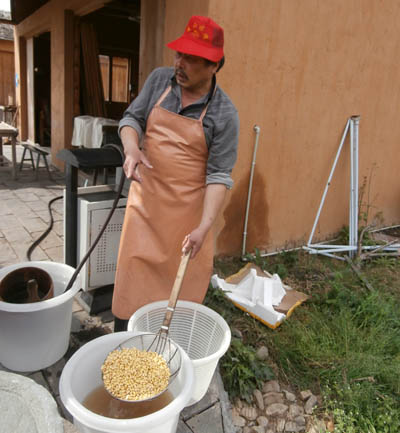 Using half a dried gourd, he scooped the soybeans into the top funnel of a grinding machine. 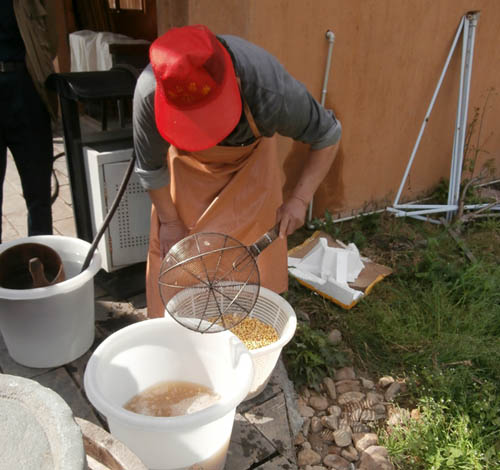 When he turned the grinder on, white liquid streamed out both sides. Next, Mr. Hu poured the white liquid into a cauldron, which he covered with two semicircular wooden lids. 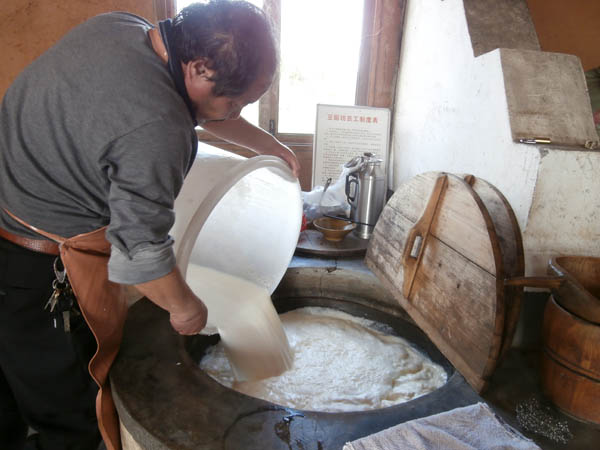 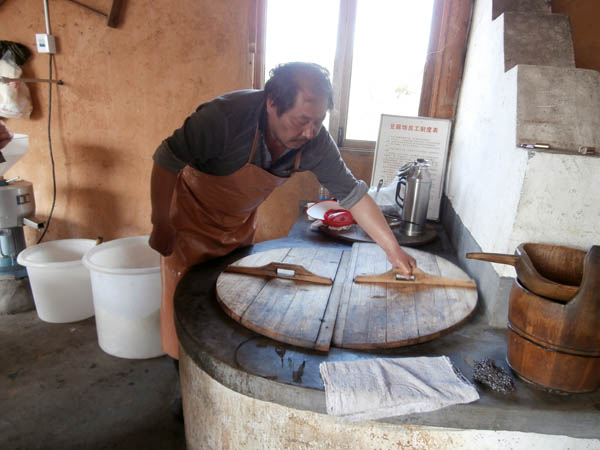 He added wood to the fire at the back of the stove and boiled the soybean milk for 40 minutes at 108 degrees Celsius. As the mixture boiled, we walked around the farm and enjoyed the sweet fragrance of the wisteria. We passed the farm’s chicken coop and were offered fresh eggs to purchase. We then walked into some of the hoop houses for growing vegetables. 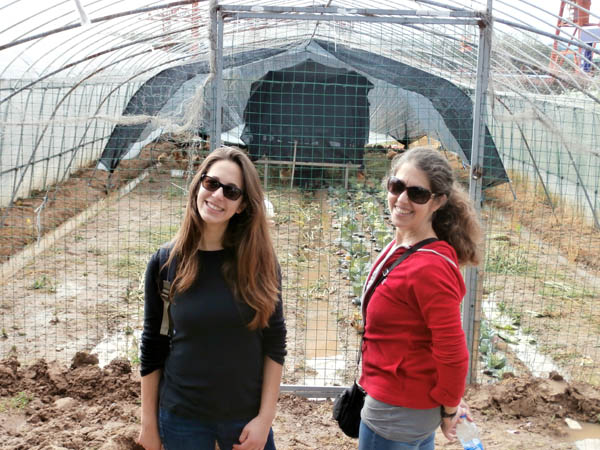 At the far end of the property, we walked along rows of peach trees and watched the farm’s 300 ducks waddle back and forth.  After we returned, Mr. Hu ladled the steaming hot tofu mixture into square wooden frames lined with cotton cheesecloth-like fabric. 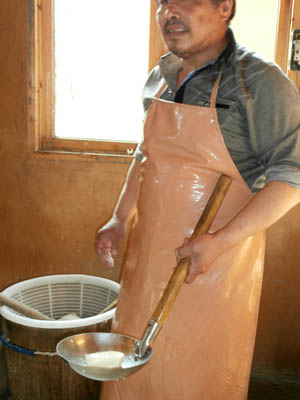 He poured some into paper cups for us to sample with spoonfuls of white sugar.  Mr. Hu gently folded the fabric over each wooden frame filled with the mixture, which looked like curds of cottage cheese. Once he had covered the frames, he removed the outside edge of each and stacked all three on top of each other. He lowered the overhead wooden beam to add weight and quicken the water drainage. Lastly, he cut up squares from the tofu he had made that morning and put four pieces in a small, clear plastic bag. We also sampled soy-sauce-marinated tofu that had been pressed by hand in cotton cloth into wafer-thin squares. The next evening, we enjoyed the fresh tofu in the spicy Szechuan style. We learned with delight that Mr. Hu wants to bring this way of making tofu to America. Posted By Karen Axelrod Sep 14, 2017
Tofu (soybean curd) is a food of Chinese origin that occurs widely in the cuisines of East Asia. Tofu is cultivated by coagulating soybean milk and then pressing the resulting curds into soft white blocks. Because it is a good source of vegetable protein, tofu has become popular throughout the world, especially among vegetarians. During a three-week trip to China, we had the opportunity not only to learn how to make tofu but also to participate in making it. In Yangshuo, a town and county in southern China’s Guangxi region, our driver and guide took us to a small local farm owned by a family named Qin. 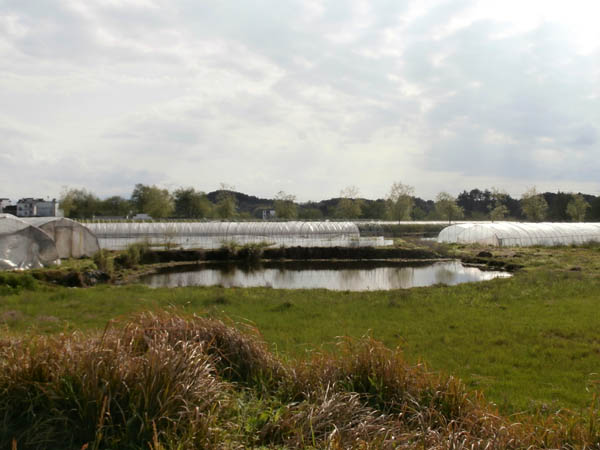 In the courtyard behind the farm’s clay-brick adobe, we ground soybeans that had been soaking in water for two hours. Using a ladle, we poured a spoonful of soybeans and water into the center of the stone mill and turned the handle counterclockwise. 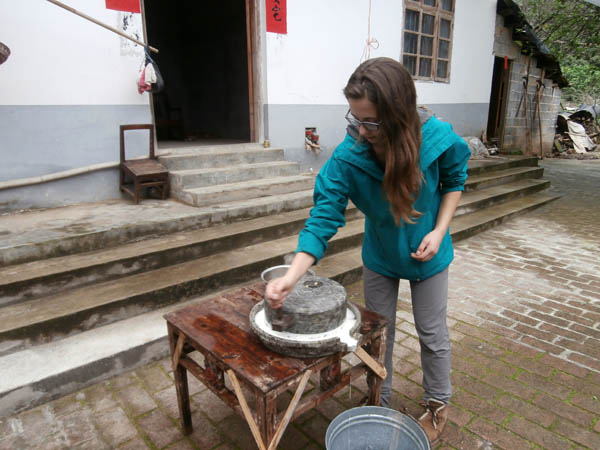 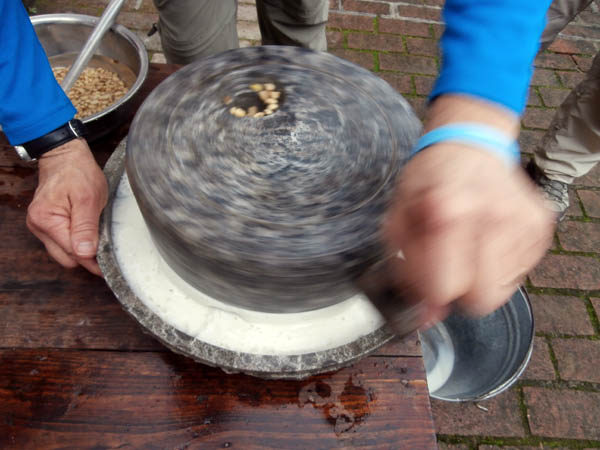 After considerable physical exertion, we were rewarded by seeing white frothy soybean milk emerge from the bottom of the circular gray stone mill and drop into the metal bucket below. 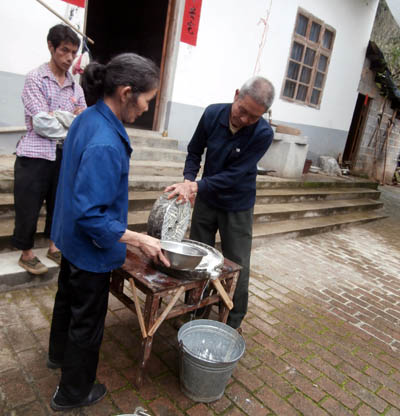 Next, the owner of the house showed us a more automated way to grind the soybeans. A small machine ground the beans, and he combined the two batches together in a red bucket. Then he and his wife tied four corners of fabric onto opposite ends of a wooden cross to create a sieve. Next, he poured the mixture into the sieve. His wife, Li Qin, occasionally dropped boiling water over the mixture. Then he swirled the fabric sieve around. Our daughter Hilary helped him rotate it.  White liquid filtered out into a bucket below. After adding gelatin, he let it set for 10 minutes. Then he draped the cloth over a shallow square wooden box.  With a red plastic pot, he ladled the resulting mixture into the cloth-covered wooden bin. Then he folded the cloth over the mixture, placed the square wooden lip on top, and pressed it down with two bricks. He let it sit and firm up for a while. Next he removed the wooden lid and flipped the box over so that the tofu wrapped in fabric was released from the mold. He gingerly pulled the fabric away from the tofu. However, it did not separate easily, so he brought it over to the well. He placed the tofu in a shallow red bucket and pumped cold water into the bucket so that the cold water could ease the separation. With patience and perseverance, and a little help from Hilary, he managed to separate the fabric. Then he cut the soft, fluffy tofu into small rectangles. His wife stir-fried it in a steaming wok heated by burning wood. They cooked us a delicious meal to share. For the mass production of tofu, a much more automated system is used. In fact, most Chinese people buy tofu at their local market rather than from a farm. They cut off a desired rectangular slab and carry it home in a small, clear plastic bag. Posted By Karen Axelrod Sep 14, 2017
|
Archives2019 2018 2017 2016 2015 2014 2013 2012 2011 2010 2009 2008 2007 |